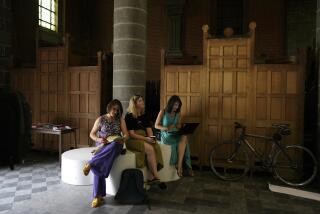Welcome to Mont St. Michel, a Toy Castle Built Upon Dreams and Faith
- Share via
MONT ST. MICHEL, France — This toy castle, as it seems from a distance, looks like a dream. In fact, it began that way.
Aubert, bishop of Avranches on the mainland, had the dream. In fact he dreamed it three times, as legend holds. Seems as if St. Michael came to him in his sleep and ordered him to build a shrine atop Mont Tombe which rose from the foggy coastal forest of Scissy a few miles south of Avranches at the historic northern boundary of Brittany in the English Channel.
“The third time, St. Michael tapped him on the side of his head so hard his finger left a dent,” said guide Jerome Rousseau. A fractured bas-relief in a dark upstairs arcade shows the archangel’s finger forcefully making its point on the slumbering bishop’s head.
It all began centuries ago, before the Normans, before Charlemagne, before the Arabs invaded Europe in 710.
In the early 8th Century, the line of Frankish kings known as the Merovingians, named for their ancestral chieftain Merovech, was fizzling out, impotent and dissolute after two centuries of fratricide, leaving a power vacuum in Gaul.
The king, Childebert III, was so ineffectual that most histories do not even mention him. His palace mayor, Pepin the Younger, was de facto ruler.
The Roman Catholic Church was the sole repository of European civilization when the first church was built on this rocky islet.
Renovated completely during the 19th and 20th centuries, it now brings in more than 1 million visitors a year.
The mont is an island at high tide, linked to the mainland only by a mile-long causeway, but it is not isolated from history. It carries within its walls the memories of 40 kings and countless dukes and peasants in layers of architecture and artifacts dating from times even more terrifying than the nuclear age.
Hotels, restaurants and tourist shops surround it, and a gold-armored statue of the archangel St. Michael can be seen shimmering 515 feet atop the church’s 19th-Century spire, which dominates the Normandy and Brittany coasts just as once this island fortress dominated invading armies and navies.
The foundation of St. Michael’s first church here, little more than a crude stone hut, was built before the end of the year 708. Childebert was one of the first pilgrims. And shortly after its completion in 709, the land sank and the sea obliterated the forest, leaving Mont St. Michel at the whim of the sea.
Churches dedicated to St. Michael, the archangel, Old Testament hero of heaven who conquered Satan, sprouted all over Europe in the Dark Ages.
Among the first was Monte Gargano in southern Italy, where it was said the angel had appeared. And Saint Michael’s Mount on the Cornish coast is almost directly across the English Channel from Mont St. Michel.
One stone wall from St. Aubert’s first church remains in a crypt below the main sanctuary at Mont St. Michel. The stones are rough-hewn and clumsy, unlike the smooth-cut granite quarried and brought in by barge from the nearby Chausey Islands in succeeding centuries.
When the Normans invaded Gaul in the late ninth and early 10th centuries, the mont became a refugee camp. When the Normans accepted the faith, they brought in Benedictine monks to build a new “pre-Romanesque” church here in 966.
In 1058, Duke Richard II of Normandy began a newer, Romanesque, church to which William the Conqueror came on pilgrimage before invading England.
Under Philippe Auguste, the monks built a dramatic 13th-Century monastery, called “the marvel,” which scales the seaward face of the mountain, reinforced by graceful buttresses that look like long, spindly fingers. It’s called the marvel because it took only 17 years to build.
During the French Revolution, 1,080 years after it was first built, Mont St. Michel became a prison, and the Benedictines were banished.
But the Jacobins couldn’t banish St. Michael from the hearts of Frenchmen. The knightly Order of St. Michael called back the heroism of the Franks. Charlemagne carried the emblem of St. Michael, as did William the Conqueror. The archangel, they believed, was strongest where danger threatened most.
More than 175 years after the last echoes of revolution faded, the Benedictine order returned to Mont St. Michel in 1966. Four monks and three nuns currently run the church.
But it is really sustained by the sleepless St. Michael, and the tourists, of course, who marvel at this graceful Gothic adventure.
More to Read
Sign up for The Wild
We’ll help you find the best places to hike, bike and run, as well as the perfect silent spots for meditation and yoga.
You may occasionally receive promotional content from the Los Angeles Times.






